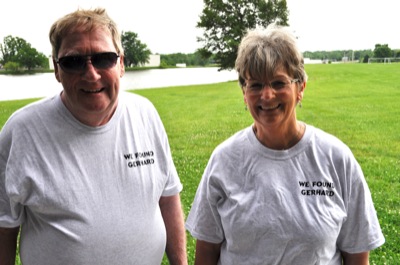Wednesday, December 30th, 2015
DNA, perseverance solve mystery
Local woman tracks down descendant of lost relative
By Claire Giesige

Submitted Photo
Glenn Kleinberg, left, and Pat Mulso pose in their "We Found Gerhard" shirts after discovering they were both descended from Wilhelm Hartings, a Mercer County farmer in the 1850s.
MARIA STEIN - After 164 years, a mystery involving a lost child was solved by one woman's tireless research and a positive DNA test.
The mystery - rooted in the Maria Stein area - began in 1850 when a young child was separated from his German immigrant family on their way to Mercer County. Family descendent Pat Mulso of Albert Lea, Minn., said the saga of the lost child was told in her family for years.
"There was a story that was passed down to us about a child who was separated from the family when they immigrated," Mulso said. "The story never died from generation to generation."
The story, as told to Mulso by an uncle, began in 1850 when the Wilhelm Hartings family landed in New York. Hartings and his wife, Mathilda, made the trip to America with their eight children in tow after selling their family farm in Germany.
It was not an easy time for the Hartings. Eight days before they left, one of their teenage daughters died unexpectedly. On the journey across the Atlantic, their youngest child, a 2-year-old boy named Gerhard, became very ill.
Because of the child's illness, the family was detained at a port of entry in New York for 10 days before receiving permission to continue their journey. However, the toddler was not released.
"They really needed to get going to claim a farm. Authorities gave them permission to leave Gerhard with a Catholic priest with the understanding that they would come back for him," said Mulso, the great-great-great-granddaughter of Wilhelm Hartings.
The Hartings family left and were bound for Iowa. However, they made it to Cincinnati where friends told them about good farmland up north, easily accessible by canal. They diverted their course and settled on a farm in the St. Rose parish near Maria Stein.
The family planted a crop and within two months Wilhelm returned to New York to reclaim his son.
"When he knocked at the rectory door, he was told the priest had gotten a calling and, not knowing if Gerhard was an orphan, took him with him," Mulso said. "I just can't imagine the devastation that that father must have felt and then to have to go back and tell the mother, after losing a daughter in Germany, that her baby was gone. ... I just can't fathom it."
Wilhelm was told the priest had been assigned to England or Australia. Mulso said she believes the priest made an honest mistake by assuming the child was an orphan because of the dangers associated with traveling at the time.
"Back then, traveling as they did, the priest wouldn't know if some kind of tragedy had befallen the family. He wouldn't have known exactly how long it would take them to get where they were going," Mulso said.
The family never saw Gerhard again. But they never forgot their lost child and the story made its way to Mulso whose mother was a Hartings.
Mulso, who describes herself as the family genealogist and serves as the executive director of a historical society in Minnesota, said she became interested in family history at a young age. As a teenager, she went on walks with her father to a cemetery where he would explain family connections among the tombstones.
Her interest in genealogy prompted her to crack the mystery of the lost child.
"I started back in the late '60s on family research," she said. "(Gerhard) was the one link I couldn't trace."
For years she looked to no avail. Then in 2007 on a trip to a genealogical library, Mulso found a listing for a "Gerhard Hartting" in an 1880 St. Louis census.
"He was married, had a family. The age and spelling was off but that wasn't uncommon back then," she said.
She eagerly followed the lead, tracking the family forward through the years. Her work led her to a family in a town south of St. Louis.
"I contacted them and told them the story. We just couldn't make the connection, though. They knew he was from Germany and didn't know about his family, but that was all we had," Mulso said.
She put the project aside until 2013. Then, after taking a DNA test for genealogy records, she had a thought.
"A light came on and I said, 'Gee, I wonder if they would take the test,' " she said.
The Missouri family agreed and after the results came in, Mulso sifted nervously through the pages of DNA matches. Happily, on the third page was the Missouri family.
"I called them and they were just ecstatic. After 164 years, we had found the descendants of this lost child," she said. "The DNA was the missing piece that we needed to say 'Yes, this was the person we needed.' "
Mulso last year attended the Missouri branch's family reunion, where she met distant cousin Glenn Kleinberg, and decided to reunite the two clans. She is planning a Hartings family reunion July 16 at the American Legion in Fort Recovery where the two sides can meet.
"Once we found this family, I just felt that because we do have a close family, that they would enjoy meeting the rest of the family that we've been missing all these years," Mulso said.
It took a lot of hard work and patience but she doesn't doubt it was worth it.
"I got the results just before Mother's Day," she said. "And I thought, you know, there's a mother in heaven that's very happy we found her lost child."
For more information about the reunion, contact Mulso at pmulso@yahoo.com or P.O. Box 889, Albert Lea, MN 56007. She hopes all Harting descendants are able to attend.



